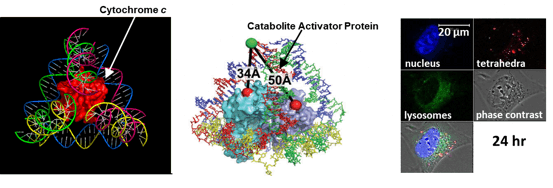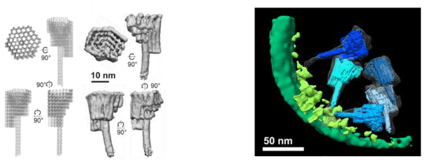
DNA nanostructures can cage proteins1,2 and enter cells3
The figures above represent experiments that motivate our research on applications of DNA nanostructures within cells. We have shown that DNA cages can enter cells and survive substantially intact for at least 48 hours1. Cages carrying biochemically active cargoes2,3 and incorporating sensing motifs that open in response to specific stimuli could be transformed into 'smart' drug delivery vehicles.

DNA origami "signposts" to label proteins in cellular cryo-electron tomograms4
We have shown that DNA nanostructures can be used to identify protein complexes in cryo-electron tomograms and are easily recognised on crowded cellular membranes.4 Our ‘‘molecular signposts’’ are targeted via an aptamer, a single-stranded RNA extension that binds specifically to a fluorescent fusion protein, providing a flexible and generally applicable platform. They can be imaged without fixation or staining and allow the tagged protein to be localized with nanometre resolution within a tomogram which (unlike a fluorescence micrograph) reveals all other cellular components with similarly high resolution. By localizing specific molecules within the rich context of a tomogram, this technology has the potential to transform cell imaging
Other current research projects include:
- intracellular delivery of DNA nanostructures
- DNA-based control mechanisms for CRISPR/Cas9 gene editing5 - a potential technology for the treatment of heritable diseases and a model application for self-assembled molecular robots operating within the cell
1. A.S. Walsh et al., ACS Nano 5, 5427-32 (2011)
2. C. Erben et al., Angew. Chem. Int. Ed. 45, 74414-17 (2006)
3. R. Crawford et al., Angew. Chem. Int. Ed. 52, 2284-88 (2013)
4. E Silvester et al Cell 184, 1110-21 (2021)
5. M. Jinek et al., Science 337, 816-21 (2012)
